![]()
![]()
![]()
Use LEFT and RIGHT arrow keys to navigate between flashcards;
Use UP and DOWN arrow keys to flip the card;
H to show hint;
A reads text to speech;
22 Cards in this Set
- Front
- Back
|
Definition of Ratios |
The ratio of a number x to another number y expresses the size of one measure x with respect to the size of another measure y. It is written as x:y and is read as “x is to y”. |
|
|
Ratio to One |
When the measure x is divided by the measure y, the relationship that x bears to y is then expressed as a ratio to one. The measure y in the denominator is called the base. |
|
|
advantages of expressing a ratio to one are: |
(i) it is easier to work with small numbers than large numbers; (ii) it facilitates the comparison of different ratios when their bases are all equal to 1. |
|
|
Interpretation of a Ratio to One: |
-If the ratio is equal to one then both measures are equal to each other. -A ratio greater than 1 means that the measure in the numerator is greater than the measure in the denominator. - A ratio less than 1 means that the measure in the numerator is less than the measure in the denominator. |
|
|
Definition of Percentage |
The relationship of x to y can also be expressed as a ratio to any number such as 10 or 100. For example,250:50 :: 50:10 or 250:50 :: 500:100. Definition: A ratio to 100 is generally referred to as a percentage. |
|
|
Special Type of Ratio: Proportion orDistribution Ratio |
The proportion or distribution ratio is a type of ratio that expresses the size of a part in relation to the size of the total collection which includes that part. The proportion is always expressed as a ratio to one. When it is expressed as a ratio to 100 then it is referred to as a percentage. |
|
|
Special Type of Ratio: Interclass Ratio |
The interclass ratio is a type of ratio that expresses the size of a part in a collection to another part in the same collection. |
|
|
Special Type of Ratio: Rate |
The term rate is a type of ratio that specifically refers to the measure of one variable considered in relation to one unit of a different variable. Examples: rate of speed (miles per 1 hour),exchange rate (peso per 1 dollar), heart rate (no. of beats per 1 minute) General usage, however, does not always observe this distinction of a rate. Example: per capita in come is still simply referred to as a ratio even if it is total income:total no. of elements in population. On the other hand, the number of deaths per 1000 people in the population is called mortality rate. |
|
|
simple relative |
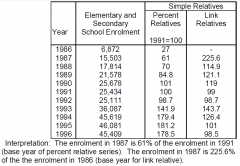
a special type of ratio that expresses the value in a time series (values of a variable arranged in a time sequence) in terms of the value in another time period called the base period. |
|
|
percent relative series |

When the base period is fixed then the series of simple relatives expressed in percentage is called a percent relative series. The base period for a percent relative series is usually identified for reporting purposes as “base period=100”. |
|
|
link relative series |
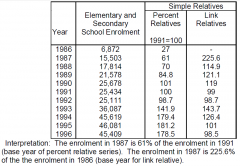
When the base period is the preceding year so that the base period moves then the series of simple relatives expressed in percentage is called a link relative series. |
|
|
Properties of Simple Relatives |
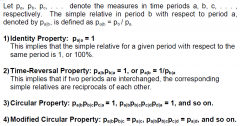
|
|
|
Analyzing Percent Relatives |
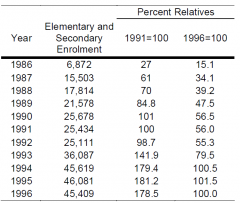
When the percent relative at time t is less than 100 then the value at time t is less than the value during the base period; while if the percent relative at time t is greater than 100 then value at time t is more than the value during the base period. |
|
|
Aside: Absolute Change vs.Relative Change (Percent Change) |
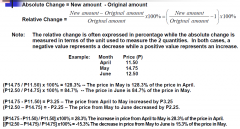
|
|
|
Analyzing Percent Relatives:Percentage Points of Change vs. Percent Change |

|
|
|
Percentage Points of Change |

|
|
|
Percent Change |

|
|
|
Averaging Ratios:Simple Arithmetic Mean vs.Weighted Mean |

|
|
|
Definition of Ratio of Sums or Means |
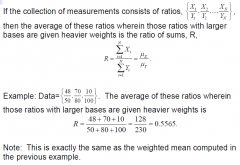
|
|
|
Averaging Link Relatives:Geometric Mean |
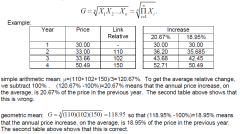
For any set of n positive numbers, the geometric mean (G) is defined ast he nth root of their product, that is, |
|
|
Remarks about the Geometric Mean |
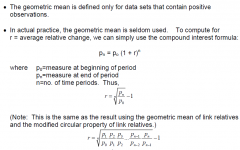
The geometric mean is defined only for data sets that contain positive observations. In actual practice, the geometric mean is seldom used. To compute forr = average relative change, we can simply use the compound interest formula: |
|
|
Averaging Rates: Harmonic Mean |
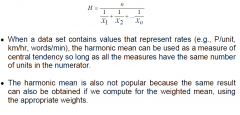
For any set of n positive numbers, the harmonic mean (H)is given by the reciprocal of the arithmetic mean of the reciprocals of the observations, that is, When a data set contains values that represent rates (e.g., P/unit,km/hr, words/min), the harmonic mean can be used as a measure of central tendency so long as all the measures have the same number of units in the numerator. The harmonic mean is also not popular because the same result can also be obtained if we compute for the weighted mean, using the appropriate weights. |

